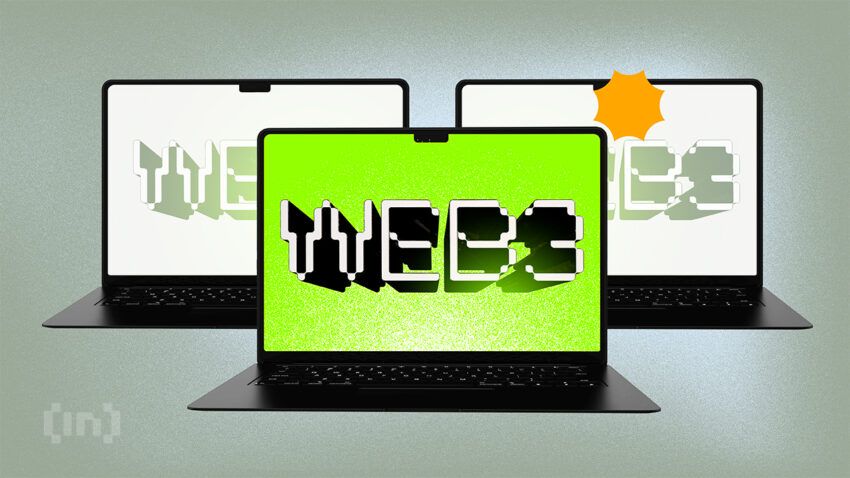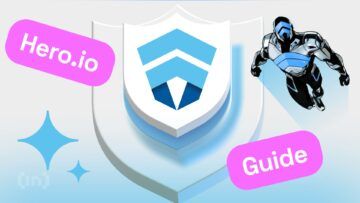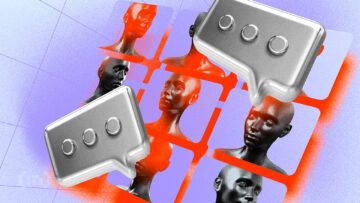Top web3 projects are pushing the boundaries of blockchain, NFTs, smart contracts, and DeFi. This guide explores some of the projects at the forefront of innovation, transforming web3 scalability, cross-chain communication, security protocols, and user experience. Discover how these advancements are shaping the future of the decentralized web.
In this guide:
- What are the leading web3 projects?
- 1. Nuklai
- 2. Guru Network
- 3. SunContract
- 4. Ethereum
- 5. Flare Network
- 6. Ocean Protocol
- 7. Oasis Network
- 8. Biconomy
- 9. Render
- 10. Injective
- Find your dream job
- Start your web3 remote career today!
- Discovering your dream project in web3
- Does web3 have a future?
- What are the disadvantages of web3?
- Get involved: Work in web3
- Frequently asked questions
What are the leading web3 projects?
1. Nuklai
Nuklai is an on-chain smart data ecosystem with the mission of becoming the bedrock of the next generation of AI that needs smart data to function. Between an experienced team, a strong ecosystem of partners in mainstream industries like Crunchbase, and a record-breaking private sale that sold out in under a minute, this project is the one to watch out for.
Through a combination of a public data marketplace, subnets for data consortiums targeted at enterprises, and the decentralized compute layer to power AI, Nuklai will fuel large language models (LLMs) with high-quality data.
The Nuklai ecosystem is built upon a layer-1 blockchain designed specifically for optimized data sharing. This foundational blockchain facilitates both public and private crypto exchanges within subnetworks that support data consortiums.
Additionally, the network oversees the allocation of computational power, ensuring that those who utilize it are validated and that nodes providing computational resources are appropriately rewarded.
A strong application layer that provides necessary data and AI infrastructure tools complements this architecture and speeds up the creation of AI-driven applications.
Key features
- LLM and AI enhancement: Nuklai revolutionizes AI by enriching, cleaning, and contextualizing data for large language models (LLMs), boosting their performance with high-quality datasets.
- AI-Blockchain synergy: Nuklai combines AI with blockchain, offering structured, interconnected data to enhance LLM and AI reliability and intelligence, laying the groundwork for advanced model functionality.
- On-Chain tools: With a suite of on-chain tools, Nuklai supports everything from data sourcing to AI tasks, enabling seamless development of sophisticated AI applications.
- Distributed computational network: Nuklai’s strong computational network fosters market growth and community engagement, is compatible with existing solutions, and supports data consortiums for industry-wide data sharing among trusted entities and startups.
Impact on the industry
Nuklai’s architecture and extensive toolkit meet the demands of data management and processing capacity, which are crucial for creating sophisticated LLMs and AI applications. In addition, the private subnets for data consortiums enable more businesses to benefit from the Nuklai infrastructure.
Nuklai facilitates the creation of new data and AI businesses while improving the training and reliability of AI models by simplifying access to structured datasets and computational resources.
With raising $2.5 million in a completely sold-out seed round and a spot in the exclusive Startup Autobahn accelerator, Nuklai has already made an impression. This accelerator gives them primary exposure to industry titans like Mercedes Benz, Porsche, and Bosch.
Additionally, they have announced top-tier data partnerships with APAC market consultancy INCITE, HU University of Applied Sciences Utrecht, and Big Data Protocol, further enhancing their network and capabilities in the field.
2. Guru Network
Guru Network is an ecosystem of products and services that merges artificial intelligence with real-world business processes. It also provides a multi-chain AI-compute layer for blockchain-based projects. These features serve as the basis for application development and deployment with minimal coding. Some of the primitives of the Guru Network include its trading terminal (DexGuru), Block Explorer, Data Warehouse, and the Guru Framework.
DexGuru was the first product of the Guru Network ecosystem. The trading terminal houses TradingView charts, token profiles, cross-chain swaps, alerts and notifications, and much more. The Block Explorer supports Ethereum-aligned appchains and offers all the standard features of top-end block explorers like Etherscan. The Data Warehouse is useful for integrating services like the Block Explorer, data querying, and using APIs, among other things. Lastly, the Guru Framework is an SDK for creating and managing DApps.
Guru Network features
- User flow orchestration driven by AI: The Flow Orchestrator coordinates activities between AI agents to automate blockchain business process automation (BBPA). It defines and dispatches processes and sources data from services across the Guru Network.
- AI agents natively embedded into routines: AI agents subscribe to various tasks and autonomously execute requests within the Guru Network. The tasks that they can execute vary widely.
- Cross-chain interoperability: The Guru Network has integrated Chainlink CCIP, which allows the network to integrate its services across multiple blockchains.
- Guru Network (GURU) token: Users can buy, sell, and trade the GURU token. It is used to distribute revenue amongst Guru Network service providers. You can also use it to pay for transactions and service fees.
Impact on the industry
While AI is great for simple tasks like multi-media content generation and data analysis, it is less useful for processes that require several steps. The Guru Network breaks the mold by creating a context-aware framework and ecosystem for AI that leverages blockchain for security.
3. SunContract
SunContract is a unique project that leverages blockchain technology for peer-to-peer (P2P) energy trading. The platform offers a unique marketplace where energy consumers and producers can trade renewable energy via smart contracts without the need for a middleman.
Users can make direct price agreements with other marketplace participants. They also choose a source of electricity, with the platform offering a range of renewables, including solar, hydro, biomass, and cogeneration. This feature empowers consumers looking to reduce their electricity costs and producers aiming to maximize returns on surplus production. The SunContract NFT marketplace is intricately connected with its peer-to-peer (P2P) energy trading platform.
Here’s how it works:
- The NFTs, which are both tradable and liquid, represent real-world solar panels.
- The energy produced is sold for SNC tokens, which will be deposited in the owner’s wallet.
- Owners can resell their NFTs on the SunContract NFT marketplace.
SunContract key features
- NFT marketplace: The NFT marketplace allows users to reap the benefits of the solar energy market without the hassle of installation and maintenance,
- Wide customer base: SunContract has a growing customer base, particularly in the E.U. region, with over 10,000 registered customers in Slovenia. The plan is to expand to other countries, too (Croatia and Estonia are first on the list).
- Payment options: All payments inside the platform are in SNC Token, but SunContract also accepts EUR payments for electricity. Note that there are no exchange rate fluctuations as the conversion from SNC token to Euros is done on the same day to facilitate daily electricity billing
- P2P marketplace: Users can make direct price agreements with other marketplace participants without a middleman. This feature empowers consumers to save more and producers to earn more from their energy resources.
- Moving energy: Excess energy can be moved freely and in real time between users and also between production sites and consumption sites for the same user.
4. Ethereum
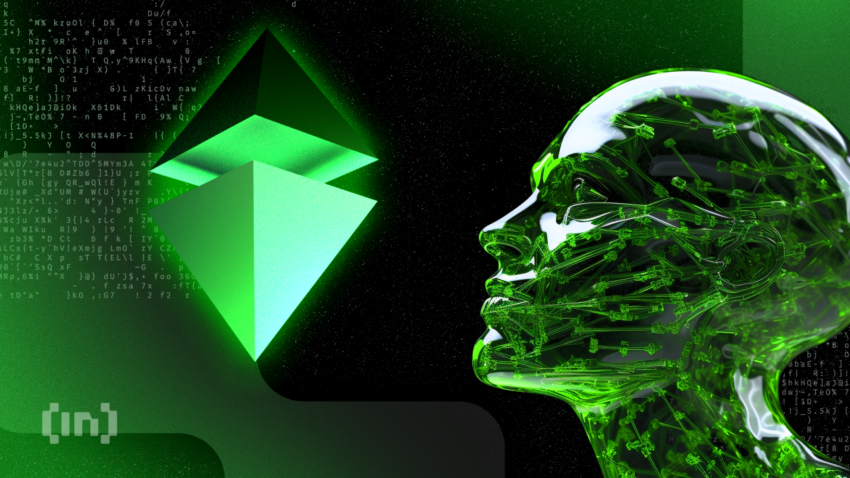
Ethereum stands out in the web3 arena because it’s the foundation for many blockchain-based projects. It’s popular for enabling quick and secure transactions and for using smart contracts — agreements that execute automatically under certain conditions. This makes Ethereum a key player in the web3 market.
The platform is continuously growing, focusing on enhancing its capacity to handle more transactions and reducing transaction fees. This commitment to improvement and transitioning to its final “Ethereum 2.0” form, which included the merge to proof-of-stake, ensured that the ecosystem was well-equipped to support existing and upcoming web3 projects effectively.
“Layer 2 solutions are pivotal, as they enhance scalability and reduce transaction costs, which in turn makes Ethereum more accessible and efficient for a broader user base. Also the increasing adoption of stablecoins on the Ethereum network significantly bolsters its utility as a financial infrastructure.”
Miguel Buffara, Lead Financial Engineer at RACE: BeInCrypto interview
The huge rise of Ethereum can also be seen in the evolution of the ETH price, the chain’s native crypto. As of June 13, 2024, ETH is the second crypto after BTC. While a number of layer-2 solutions fight for dominance, the base chain’s importance continues to grow as more projects are launched and evolve on the Ethereum network.
Key features
- Smart contracts: Self-executing contracts with the terms of the agreement directly written into code. These contracts run on the blockchain and execute automatically when conditions are met.
- Ethereum Virtual Machine (EVM): A powerful software platform that enables developers to build and deploy decentralized applications (DApps).
- Decentralization: Ethereum operates on a global network of public nodes, ensuring no central point of failure and increased security.
- Blockchain technology: Ethereum’s public ledger records all transactions, which are immutable and verifiable.
- Gas fees: Transaction fees in Ethereum, known as “gas,” are paid in Ether (ETH), which is Ethereum’s native cryptocurrency. The fees vary based on computational complexity, bandwidth use, and storage needs.
- Consensus mechanism: Initially using proof-of-work (PoW), Ethereum has transitioned to proof-of-stake (PoS) for enhanced energy efficiency and scalability.
- Tokenization: Ethereum allows the creation of tokens (ERC-20, ERC-721, etc.) representing a variety of assets and utilities.
- Interoperability and composability: Ethereum’s open standard allows for interoperability between different products and services on its network.
Impact on the industry
Ethereum has significantly impacted the web3 industry by pioneering smart contracts and decentralized applications (DApps). Its flexible platform has led to the growth of decentralized finance (DeFi) and the surge in non-fungible tokens (NFTs), reshaping how digital transactions and agreements are made. Ethereum’s continual improvements, especially in scalability and efficiency, set industry standards and drive innovation across the web3 ecosystem.
5. Flare Network
The Flare Network takes its place as a top web3 project, revolutionizing the concept of cross-chain functionality. Unlike previous systems that relied on slower, less secure token bridges, Flare offers a more powerful solution, allowing various blockchain networks to interact seamlessly and securely. This interoperability is pivotal for a workable decentralized future in web3.
Flare’s approach addresses the security concerns and inefficiencies of traditional token bridges. By providing a faster, more secure means for cross-chain transactions, the network enhances the overall efficiency and reliability of the blockchain ecosystem.
An integral part of Flare’s appeal is its developer-friendly environment. The network offers a comprehensive incentive program, encouraging developers to contribute to and grow the ecosystem. This support helps foster innovation and the development of diverse applications on the Flare Network.
Another key feature of Flare is its State Connector. This tool allows decentralized applications (DApps) on Flare to access external data sources, bridging the gap between blockchain and real-world information. This capability is crucial for expanding the DApp functionality and use cases.
Could some of your skills be put to use building a top web3 project? Check out our complete guide to jobs in web3 to learn more.
Key features
- Cross-chain interoperability: Flare enables seamless interaction between different blockchain networks, enhancing communication and transaction efficiency across various platforms.
- Enhanced security: Addressing the vulnerabilities of traditional token bridges, Flare offers a more secure method for cross-chain transactions, reducing the risk of security breaches.
- State Connector: A unique tool that allows decentralized applications on Flare to access and utilize real-world data. The State Connector bridges the gap between blockchain networks and external information sources.
- Developer incentive program: Flare provides incentives for developers, encouraging innovation and growth within its ecosystem through financial rewards and support.
- Decentralized framework: It upholds the ethos of decentralization, ensuring that its operations and transactions are not controlled by any single entity, thereby enhancing trust and transparency.
- Speed and efficiency: Flare’s architecture is faster and more efficient than traditional blockchain networks, particularly in handling cross-chain functionalities.
Impact on the industry
Flare Network, a top web3 project, drives innovation with its advanced cross-chain communication technologies. It enhances web3 security protocols, contributing to safer and more efficient decentralized finance (DeFi) platforms and NFT marketplaces.
Flare’s integration of smart contracts and decentralized data solutions is pivotal in developing web3 scalability solutions, making it a key player in blockchain’s role in web3 gaming, metaverses, and DAOs.
Find your dream job
Start your web3 remote career today!
6. Ocean Protocol
Another top web3 project, Ocean Protocol, transforms how data is shared, sold, and utilized. It’s a decentralized data exchange protocol that allows individuals and organizations to exchange and monetize data securely and privately. Ultimately, it’s a data-sharing project primarily for AI initiatives. By combining artificial intelligence (AI) with web3 technologies, the protocol enables data owners to monetize their data while providing a marketplace for consumers. The project’s native ERC-20 token, OCEAN, is one of the leading AI cryptocurrencies.
In the employment market, integrating AI and blockchain in projects like Ocean Protocol creates unique positions that can be among the highest-paying freelance jobs in the tech and digital asset sectors.
Key features
- Decentralized data exchange: Ocean Protocol allows secure and transparent sharing and trading of data, enabling a decentralized marketplace for data.
- Data tokenization: It facilitates the tokenization of data, turning data into assets that can be bought, sold, or traded using Ocean’s own tokens.
- Data sovereignty and privacy: The protocol emphasizes user control over data, ensuring data providers retain ownership and control over their data.
- OCEAN token: Used within the network for transactions, incentivizing data providers, and participating in governance.
- Staking and governance: OCEAN holders can stake their tokens to participate in network governance and influence decisions about the protocol’s future.
- Integration with AI and blockchain: Ocean combines AI and web3 technologies, offering a platform for AI-driven data services and applications.
Impact on the industry
Ocean Protocol enables decentralized data exchange and monetization by cohesively integrating AI and blockchain. In a crowded market filled with a sea of pseudo-AI buzzword projects, often with only a few automated or AI-powered aspects, Ocean Protocol’s clear use cases advance data-driven applications in sectors like DeFi and NFT marketplaces.
7. Oasis Network
Oasis Network’s architecture prioritizes user privacy, supports data tokenization, and allows users to control and monetize their data assets securely. This combination of features makes Oasis Network crucial to enhancing privacy and security within the web3 and AI sectors.
The network’s native token, ROSE, supports governance and staking and incentivizes participation. The Oasis Network’s focus on privacy and data protection mirrors the growing demand for web3 data storage and privacy solutions — and simultaneously, the specialist professionals needed to run and code these operations.
Key features
- Decentralized privacy protection: Oasis Network offers a groundbreaking approach to privacy. It uses advanced technologies to ensure user data remains confidential and secure, aligning with web3 data storage and privacy solutions.
- Tokenization of data assets: It enables users to convert their data into secure, tradable assets, fostering innovative approaches in data sharing and web3 tokenomics.
- Confidential computing capabilities: Oasis Network leverages secure computing techniques. This ensures data privacy even during complex computations, which is crucial for web3 security protocols.
- Smart contracts for privacy-centric applications: The network supports privacy-enhanced smart contracts, enabling the creation of DApps that prioritize data security. This contributes to the evolution of web3 gaming, DeFi, and metaverse projects.
- ROSE token utility: The native ROSE token facilitates various network functions, including governance, staking, and incentivizing participation, reflecting the decentralized governance models in web3.
- Scalable and secure consensus mechanism: Oasis Network’s consensus mechanism ensures high throughput and security, which are crucial for sustainable and scalable blockchain projects in the web3 ecosystem.
Impact on the industry
Oasis Network pioneers privacy-focused blockchain solutions and enhancing data security protocols. It supports advanced smart contracts, contributing to the growth of decentralized finance (DeFi) platforms, web3 gaming, and metaverse projects.
Through its ROSE token, Oasis offers a great example of web3 tokenomics and decentralized governance. Its focus on sustainable and scalable blockchain solutions aligns with the needs of the web3 ecosystem, positioning it as a key player in advancing blockchain innovation and secure, user-centric applications.
8. Biconomy
Biconomy streamlines user interactions with blockchain technology. The top web3 project addresses a critical pain point in the decentralized world: the complexity of blockchain transactions. By simplifying these transactions, Biconomy enhances user experience, making it easier for people to engage with decentralized applications (DApps) without extensive technical know-how.
This simplification is crucial in broadening the appeal and accessibility of web3 technologies, including decentralized finance (DeFi) platforms and NFT marketplaces.
A key aspect of Biconomy is its approach to managing gas fees (costs associated with executing transactions on networks like Ethereum). By enabling DApp developers to subsidize these fees, Biconomy enhances transaction efficiency. Furthermore, it reduces user costs, aligning with web3’s aim to create inclusive digital ecosystems.
Key features
- Transaction simplification: Biconomy makes blockchain transactions user-friendly, reducing the complexity of end-user interaction with decentralized applications (DApps).
- Gas fee management: It offers solutions for managing gas fees. These include options for DApp developers to subsidize them, leading to more predictable and user-friendly cost structures.
- Cross-chain compatibility: Biconomy is designed to support cross-chain transactions, enhancing interoperability among different blockchain networks.
- Meta-transactions: This feature allows users to interact with DApps without holding native blockchain tokens, simplifying the process and broadening access.
- SDK and APIs: Biconomy provides a set of software development kits (SDKs) and APIs, making it easier for developers to integrate its features into their DApps, thereby enhancing user experience and engagement.
- Non-custodial approach: Biconomy ensures that users maintain control over their assets.
Impact on the industry
Biconomy is making a significant impact in the web3 industry by simplifying blockchain transactions, thereby enhancing user accessibility and experience. Biconomy’s gas fee management and cross-chain compatibility drive DApp adoption, especially in the DeFi and NFT sectors.
9. Render
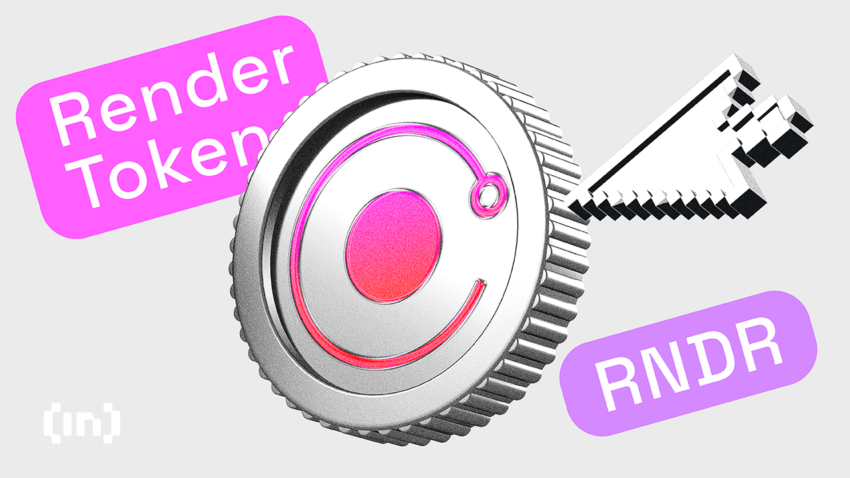
The Render project leverages blockchain technology to transform digital rendering in industries like gaming, virtual reality, and filmmaking. Built on the Ethereum network, Render creates a decentralized network for 3D graphics rendering, utilizing idle GPU power worldwide. Participants contributing GPU power are rewarded with the native render RENDER.
This blockchain integration ensures transparency and efficiency in rendering tasks and token distribution, making high-quality rendering more accessible and providing a novel use case in the web3 sector.
Key features
- Decentralized rendering network: Utilizes a distributed network of GPUs for efficient and high-quality 3D rendering, making advanced graphics more accessible.
- Utilization of idle GPU resources: This technique taps into the unused GPU power of individual computers worldwide, offering a cost-effective solution for rendering tasks.
- RENDER token economy: Features the Render Token (RENDER) as its native cryptocurrency, used to facilitate transactions, compensate GPU providers, and manage rendering services within the ecosystem.
- Blockchain-powered transparency: Integrates blockchain technology to ensure transparent and secure distribution of rendering tasks and rewards.
- Accessibility for content creators: This provides an accessible platform for content creators, such as those in gaming and filmmaking, who require high-quality rendering services.
- Contribution and incentivization: This feature allows GPU owners to contribute their idle resources to the network and be rewarded, incentivizing participation and resource sharing.
Impact on the industry
The Render Network project is a disruptor within industries reliant on digital rendering — like gaming and filmmaking — by offering decentralized, cost-effective 3D graphics processing. Leveraging idle GPU resources worldwide, it democratizes high-quality rendering while optimizing hardware use.
Its blockchain integration ensures transparent and fair task distribution, creating a symbiotic ecosystem where GPU owners earn from idle resources and content creators access affordable rendering. This innovative blend of blockchain and rendering technologies is reshaping the digital content creation sector.
10. Injective
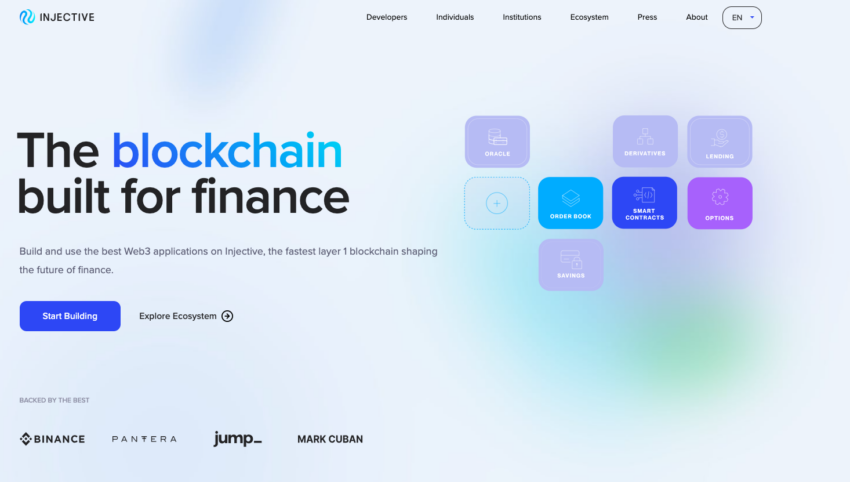
The Injective project is a decentralized finance (DeFi) platform known for its high-performance, interoperable blockchain optimized for creating and trading various financial instruments. It enables the creation of new markets, including derivatives and futures, in a completely decentralized and permissionless ecosystem.
Injective leverages advanced blockchain technology to offer secure, fast, and fully decentralized trading experiences, appealing to a wide range of users in the DeFi space. Its focus on interoperability and user-centric features positions it as a notable player within decentralized finance ecosystems.
Key features
- Decentralized finance (DeFi) trading: Offers a fully decentralized platform for trading various financial instruments, including derivatives and futures.
- High-performance blockchain: Built on a high-speed blockchain network, enabling fast and efficient trading experiences.
- Interoperability: Designed for cross-chain interoperability, allowing seamless integration with multiple blockchain networks.
- Permissionless market creation: Users can create and list their own markets, promoting innovation and diversity in trading options.
- Secure and trustless system: Utilizes advanced security protocols to ensure a secure and trustless trading environment.
- Zero gas fees: Offers a gas-free trading experience, enhancing accessibility and user convenience.
Impact on the industry
The Injective project’s permissionless market creation furthers the democratization of finance, while its interoperability and zero gas fee structure enhance accessibility and efficiency. These features position Injective as a key innovator in expanding the capabilities of web3 and DeFi as a whole.
Discovering your dream project in web3
Embarking on a journey to join your dream project (or even creating your own) in web3 can be exciting and overwhelming. To help you navigate this new frontier and avoid job search burnout, here are tangible steps to get you started. Whether you’re new to the space or an experienced web3 tech professional, these tips will guide you toward finding a project that aligns with your interests and skills while addressing common challenges in web3.
- Define your interests and skills: Identify what areas of web3 excite you the most and match your skills. This clarity will help you target the right opportunities.
- Research the market: Explore various projects and companies. Follow industry news, join web3 crypto communities, and stay updated on trends to understand where your interests align.
- Network actively: Join forums, attend virtual events, and connect with industry professionals. Networking can open doors to opportunities that are not advertised publicly.
- Update your profile and portfolio: Ensure your resume, LinkedIn, and any relevant portfolios showcase your skills and experience in web3. Highlight projects and technologies you’ve worked on.
- Apply strategically: Target your applications to projects that truly interest you. Tailor your cover letters and resumes to each opportunity, showing how your skills can benefit the project.
- Prepare for interviews: Be ready to discuss your experience, understanding of web3, and how you can contribute to the project. Practice common interview questions and scenarios.
- Stay grounded: Rejections are part of the process. Learn from feedback, continuously improve your approach, and apply to new opportunities.
- Be wary of high-stress environments: Be aware of common challenges like remote work dynamics, security concerns, and the fast-paced nature of the industry. Prepare yourself to tackle these challenges effectively.
Does web3 have a future?
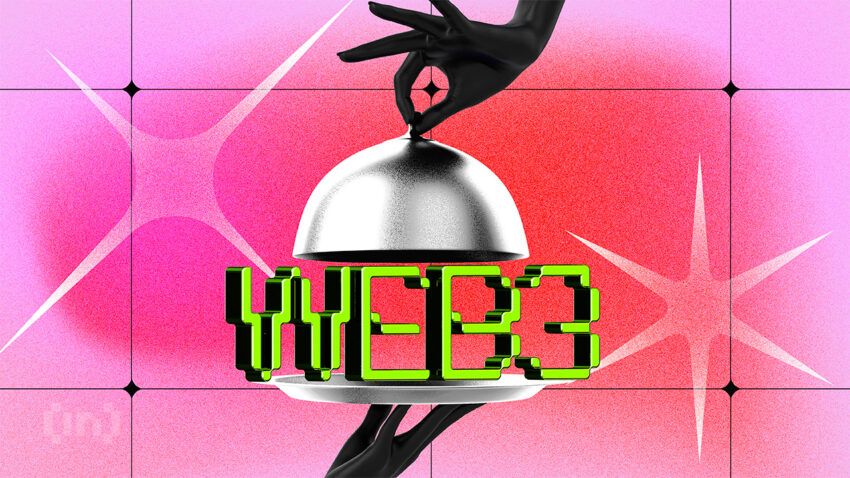
Web3 certainly appears to have a bright future. The emergence of top web3 projects across various domains, including decentralized finance (DeFi) platforms, NFT marketplaces, and web3 gaming, highlights the growing interest and investment in this space.
These developments leverage blockchain innovation, offering new ways of interacting and engaging online. These projects also create a number of web3 jobs for those looking to advance in the tech sector, including non-tech jobs. Smart contracts are a cornerstone of web3, enabling automated and trustless transactions. Their vast applications range from DeFi to digital identity verification, enhancing security and efficiency.
DAOs (decentralized autonomous organizations) are another significant aspect of web3, redefining governance models and decision-making processes in a decentralized manner.
Advancements in cross-chain communication technologies and web3 scalability solutions are addressing some of the key challenges faced by earlier blockchain systems, such as interoperability and transaction speed. Moreover, the focus on web3 data storage and privacy solutions reflects a growing concern for user privacy and data sovereignty.
Sustainable blockchain projects and eco-friendly initiatives in web3 address environmental concerns, making blockchain technology more sustainable. This is crucial for the long-term viability and acceptance of web3 technologies. In education, knowledge sharing, and social networking, web3 fosters new platforms for collaboration and community building, demonstrating the potential of the space to revolutionize various aspects of our digital lives.
What are the disadvantages of web3?
Web3 has its drawbacks. One major challenge lies in its complexity; the underlying technologies of web3, such as blockchain and smart contracts, are often difficult for the average person to understand.
This steep learning curve poses a barrier to widespread adoption as users struggle to navigate these new systems. Additionally, the scalability of blockchain networks, crucial for the success of web3, remains a significant concern. Many existing blockchain frameworks struggle to process high volumes of transactions quickly and cost-effectively, which is essential for mainstream applications. Concerns about energy consumption accompany this scalability issue. This is particularly true with networks relying on energy-intensive proof-of-work (PoW) consensus mechanisms.
Furthermore, the security and regulatory sector of web3 presents another set of challenges. While blockchain is inherently secure, the broader web3 ecosystem is susceptible to various cyber threats, including scams and vulnerabilities in smart contracts.
The decentralized nature of these technologies can complicate efforts to establish regulatory oversight and consumer protections, leading to a sector of legal and financial uncertainty. This is compounded by the inherent volatility of the cryptocurrency market, which can deter potential users and investors.
Lastly, the reliance on cryptocurrencies for transactions in the web3 space can be a barrier, either due to a lack of understanding or trust in digital currencies. All these factors contribute to a scenario where, despite its transformative potential, web3 faces significant hurdles that must be addressed in order to achieve sustainable and equitable growth.
Get involved: Work in web3
These top web3 projects highlight this growing space’s incredible diversity and innovation. From decentralized finance and NFT marketplaces to blockchain development and remote crypto jobs, each project showcases a unique aspect of web3’s potential. This booming industry offers groundbreaking and lucrative career opportunities, reflecting its rapid growth and significant impact on the digital sector. For professionals aiming to advance in the decentralized internet space, exploring the highest-paying web3 jobs can reveal valuable opportunities in this cutting-edge field.
Frequently asked questions
Web3 is a decentralized internet ecosystem that leverages blockchain technology to provide peer-to-peer interactions without intermediaries. Web3 represents the next evolution of the internet, promoting transparency, security, and user ownership.
Web2 refers to the current state of the internet, characterized by centralized platforms where a few major companies largely hold data and control. In contrast, web3 uses blockchain technology to decentralize control, giving users direct ownership and management of their data and digital assets.
One example of a web3 project is Ethereum, a blockchain platform that enables decentralized applications and smart contracts. It allows users to interact with applications and exchange digital assets without relying on traditional intermediaries like banks. Ethereum’s technology has paved the way for various web3 applications, including decentralized finance (DeFi) platforms and non-fungible token (NFT) marketplaces.
Numerous companies spearhead the web3 movement, pioneering blockchain technology and decentralized applications. Among the prominent leaders are Ethereum, Solana, Binance Smart Chain, Polkadot, Cosmos, and Avalanche. These blockchain platforms have garnered substantial momentum, propelling innovation in the web3 domain, where many projects and applications thrive on their networks.
Web3 holds the potential for positive advancements, such as increased decentralization, improved security, and greater control over personal data. It can revolutionize industries like finance, gaming, and data sharing, offering new opportunities for innovation and empowerment. However, there are also concerns related to web3, including issues with privacy, regulatory challenges, and environmental impacts.
Web3 skills encompass blockchain development, smart contract expertise, and decentralized finance (DeFi) and NFTs proficiency. These skills enable individuals to navigate and contribute to the decentralized digital sector of web3.
You don’t need to have prior experience in web3 to get started. Many projects welcome newcomers who are eager to learn and contribute. However, having a basic understanding of blockchain technology and relevant skills can give you an edge. Gaining experience through online courses, participating in like-minded communities, and working on personal projects can also help you transition into this field smoothly.
Disclaimer
In line with the Trust Project guidelines, the educational content on this website is offered in good faith and for general information purposes only. BeInCrypto prioritizes providing high-quality information, taking the time to research and create informative content for readers. While partners may reward the company with commissions for placements in articles, these commissions do not influence the unbiased, honest, and helpful content creation process. Any action taken by the reader based on this information is strictly at their own risk. Please note that our Terms and Conditions, Privacy Policy, and Disclaimers have been updated.


